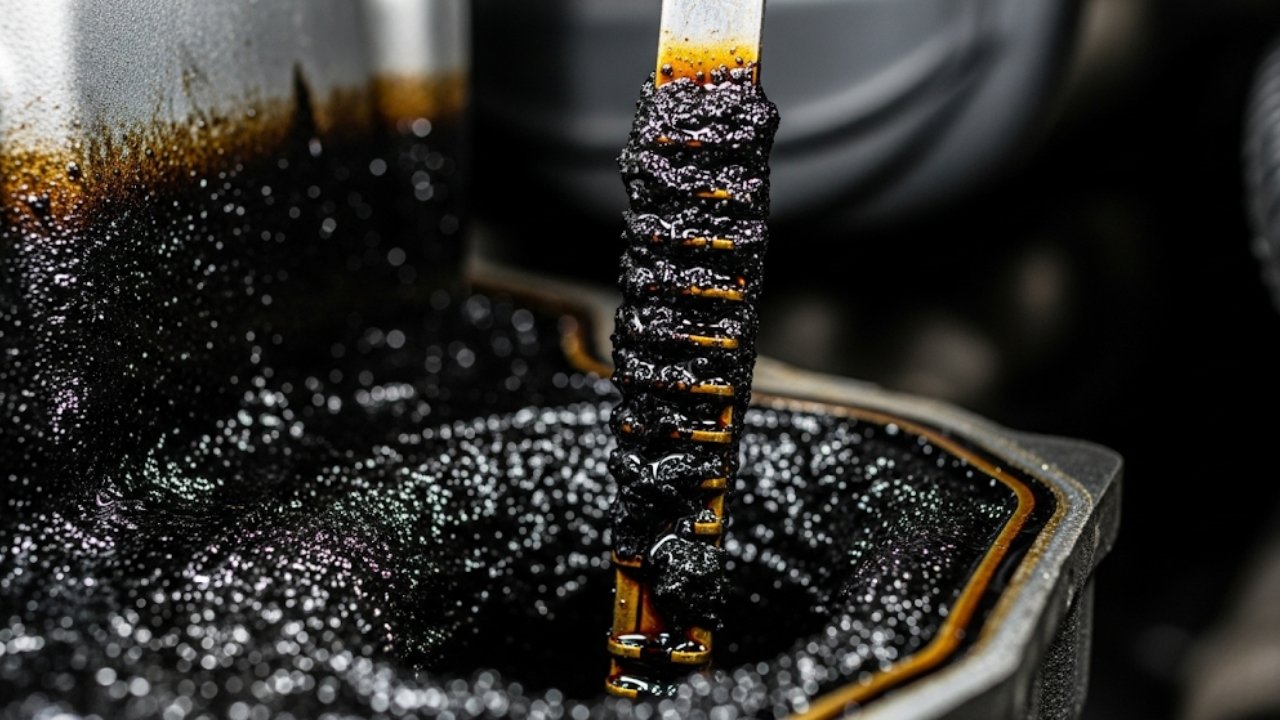What Does Bad Oil in a Car Look Like?

Picture this: You’re driving on a quiet country road, windows down, good music playing. Life feels smooth—until your engine starts making a weird ticking noise. You brush it off, maybe it’s the fuel. But a week later, your car stutters and shuts down mid-drive. A mechanic opens the hood, pulls out the dipstick, and frowns. “Your oil’s bad,” he says.
That one sentence can be the difference between a quick fix and a costly repair.
If you’ve ever asked yourself, “What does bad oil in a car look like?”, you’re already ahead of the game. Most people don’t realize that oil isn’t just about lubrication—it’s your engine’s lifeline. Knowing what bad oil looks, smells, or even feels like could save you thousands.
In this guide, we’ll talk like friends at a coffee shop. No jargon. Just straight talk, honest signs, stories from the road, and practical advice. Let’s dive under the hood together.
Why Engine Oil Matters More Than You Think

Think of your engine as a beating heart. Now imagine it pumping without blood. That’s what happens when you run your car with dirty, old, or wrong oil. Motor oil lubricates moving parts, keeps things cool, and collects dirt so your engine can stay clean. When oil goes bad, it can’t do any of that.
Here’s what good oil does:
-
Lubricates parts and reduces friction
-
Cools the engine by transferring heat
-
Traps debris and keeps the system clean
-
Prevents rust and corrosion
-
Supports overall engine performance
Now here’s what bad oil does:
-
Turns thick and sludgy
-
Loses lubrication
-
Overheats the engine
-
Causes metal-on-metal damage
-
Leads to complete engine failure
So yes, that little golden-brown liquid has a big job. And if it’s not in good shape, neither is your car.
What Does Bad Oil in a Car Look Like?
Let’s get into the core of the question. You don’t need to be a mechanic to know when something looks off. If you’ve ever looked at your car’s oil and wondered if it’s still good, here’s how to tell.
1. Dark and Dirty Appearance
Fresh oil is usually light amber or golden brown. It looks smooth, clean, and almost transparent. But bad oil? It turns dark, murky, and sometimes even black.
Why does this happen?
Because oil collects dirt, grime, metal particles, and carbon from the combustion process. Over time, these contaminants turn your clean oil into something that looks like thick coffee sludge.
Quick Test: Pull out your dipstick, wipe it clean, reinsert it, and pull it out again. If the oil looks black, thick, or gritty, it’s time for a change.
2. Milky or Foamy Texture
If your oil looks like chocolate milk or has a milky texture, this is a red flag. It often means coolant is leaking into your oil—usually due to a blown head gasket or cracked engine block.
That’s not just bad oil, that’s a mechanical emergency.
Also, foamy oil can indicate water contamination or overfilling. Either way, the oil won’t lubricate properly.
3. Grit or Metal Particles in the Oil
Touch the oil with your fingers. Feel anything gritty? That’s not normal. If your oil has tiny metal shavings, it could mean your engine parts are wearing down and rubbing together. This is a clear sign the oil has lost its protective qualities.
You can use a magnet or white cloth to check. If metal shows up, get your car inspected immediately.
What Does Bad Oil Smell Like?
Your nose knows. Don’t ignore weird smells coming from your engine.
-
Burnt smell: If it smells like burnt toast or hot rubber, the oil has overheated.
-
Sweet smell: Could be coolant mixing with the oil.
-
Gasoline smell: This may mean fuel is leaking into the oil system, reducing viscosity.
If your oil smells off, it likely is off.
What Does Bad Oil Feel Like?
Yes, it’s okay to touch the oil (just wash your hands after). Feel the texture.
-
Good oil: Smooth, slippery, easy to rub between fingers.
-
Bad oil: Sticky, gritty, thick like syrup, or slimy.
Oil that’s too thin or too thick can both cause problems. You want oil that feels like olive oil, not honey or water.
How to Check for Bad Oil: Step-by-Step Guide
Even if you’re not a “car person,” this is simple.
What You Need:
-
Clean rag or tissue
-
Gloves (optional)
-
Flashlight (if it’s dark)
-
Your owner’s manual (to know where the dipstick is)
Steps to Check Your Oil:
-
Turn off your engine and let it cool for 10-15 minutes.
-
Open the hood and locate the dipstick.
-
Pull it out and wipe it clean.
-
Reinsert fully, then pull it out again.
-
Check color, texture, and smell.
-
Look at the oil level too. Low levels mean trouble.
Bad Oil Symptoms While Driving
You might not pop your hood every day, but your car tells you when something’s wrong.
Here are signs your oil might be bad without even checking it:
-
Engine noise or knocking
-
Ticking sounds at startup
-
Oil warning light on dashboard
-
Decreased fuel efficiency
-
Smoky exhaust
-
Rough idling or jerking
-
Burning smell inside cabin
If your car feels sluggish or sounds like it’s gasping for help, the oil could be the reason.
Quick Table: Good vs. Bad Oil
| Feature | Good Oil | Bad Oil |
|---|---|---|
| Color | Amber or light brown | Dark, black, or milky |
| Texture | Smooth, slick | Gritty, thick, sludgy |
| Smell | Mild or none | Burnt, sweet, or gassy |
| Performance Impact | Efficient, quiet engine | Noisy, overheating, sluggish |
| Oil Light | Off | Often blinking or solid red |
How Often Should You Change Your Oil?
Here’s a rule of thumb, but always check your owner’s manual:
-
Conventional oil: Every 3,000 to 5,000 miles
-
Synthetic oil: Every 7,000 to 10,000 miles
-
Older engines: Stick to shorter intervals
-
Short trips in cold weather? Change more often
Pro Tip: Time matters too. If it’s been 6 months—even if you haven’t hit the mileage mark—your oil may still break down.
What Happens If You Ignore Bad Oil in Your Car?
Ignoring bad oil is like ignoring a cough that won’t go away. At first, it’s just an annoyance. But if untreated, it grows into something serious. Let’s talk about what happens when you keep driving with oil that’s old, dirty, or contaminated.
1. Engine Overheating
Bad oil can’t cool your engine. It’s lost its ability to transfer heat. So what happens? Your engine starts to run hot. If you ignore this, it can warp metal components or even lead to a blown head gasket.
2. Increased Friction and Wear
Old oil is thick, sticky, and full of debris. This increases friction between metal parts. Friction leads to heat. Heat leads to damage. Damage leads to costly repairs—or worse, engine failure.
3. Complete Engine Breakdown
Eventually, the engine parts can seize up. Once the internal components grind together without proper lubrication, the engine could shut down completely. Replacing an engine isn’t cheap. You could be looking at $3,000 to $7,000 or more.
4. Oil Filter Clogs
Dirty oil doesn’t just affect the engine. It clogs the oil filter, which is supposed to trap harmful debris. Once the filter clogs, dirty oil circulates freely—speeding up internal wear.
5. Emission System Problems
Contaminated oil can damage the catalytic converter—a crucial part of your emissions system. Replacing it could cost $1,000+. And if your vehicle can’t pass an emissions test, it’s off the road until fixed.
So yes—bad oil might seem like a small issue, but it can create a domino effect of mechanical disasters.
How to Prevent Your Car Oil from Going Bad
The good news? Preventing oil issues isn’t hard. With a bit of attention and routine care, your car can run like a dream for years.
Follow These Simple Tips:
-
Change oil on time: Stick to manufacturer guidelines.
-
Use the right oil: Always use oil that matches your car’s specifications (viscosity, type).
-
Check oil monthly: Make it a habit. Takes 2 minutes.
-
Change oil filter too: Every oil change should include a new filter.
-
Avoid short trips: Engines need time to reach full operating temperature to burn off moisture.
-
Warm up your car in winter: Cold oil is sluggish. Let it warm up before driving hard.
-
Don’t overfill: Too much oil can cause foaming, leading to poor lubrication.
A little prevention is always cheaper than a major repair.
Oil Change Myths You Should Ignore
Let’s clear the air on some common oil-related myths. These false beliefs can damage your engine or waste your money.
❌ Myth 1: Change Oil Every 3,000 Miles—Always
Modern engines and synthetic oils can often go up to 7,500 or even 10,000 miles. Always check your owner’s manual, not outdated rules.
❌ Myth 2: If It’s Black, Change It Immediately
Oil darkens naturally as it works. Dark color doesn’t always mean it’s bad—feel and smell matter more.
❌ Myth 3: You Can’t Switch Between Synthetic and Conventional
You can switch between the two, as long as the oil meets your car’s needs. Just don’t mix them randomly.
❌ Myth 4: Topping Off Is the Same as Changing
Topping up might fix a low level, but it doesn’t clean out the sludge or contaminants. Eventually, you need a full oil change.
When Should You Check Your Oil?
Routine checks are like brushing your teeth. Small act, big benefit.
Check your oil:
-
Every 30 days
-
Before a road trip
-
After rough driving (towing, mountains, traffic jams)
-
If the oil light blinks
-
When your engine feels “off”
Keep a bottle of oil in your trunk, just in case. Think of it like carrying an umbrella—you may not always need it, but you’ll be glad it’s there.
FAQs: What Car Owners Ask About Bad Oil
1. What color is oil when it’s bad?
Bad oil is usually dark brown or black, sometimes gritty or sludgy. If it looks milky, coolant may be leaking into the oil.
2. Can bad oil cause my car not to start?
Yes. If the oil is too thick, dirty, or empty, the engine may struggle to start or refuse altogether. No lubrication = no action.
3. What happens if I go too long without changing oil?
You risk engine damage, oil sludge, clogged filters, and complete breakdown. Always stick to a regular schedule.
4. Can I just top off bad oil instead of changing it?
Topping off helps with low oil levels but doesn’t remove debris or restore quality. Dirty oil needs to be fully drained and replaced.
5. How do I know if my oil is bad without opening the hood?
Listen for:
-
Ticking or knocking
-
Poor acceleration
-
Burning smells
-
Check engine or oil light
These are red flags. Time to inspect under the hood or visit a mechanic.
6. Does synthetic oil go bad too?
Yes, though it lasts longer. Synthetic oil can still become contaminated and degrade with heat, moisture, and wear.
7. What does burnt oil smell like?
It smells like burnt toast or plastic—a clear sign your oil is too old or overheating. Get it changed fast.
Personal Reflection: My Wake-Up Call with Bad Oil
A few years ago, I drove an old Honda Civic I loved like a family pet. I pushed it hard—long road trips, late-night drives, blazing summers. I ignored oil checks, thinking, “It’s fine—it’s just oil.”
One day, on a highway in Arizona, my engine began ticking. Within minutes, the oil light came on. I pulled over. The dipstick? Sludgy and black. That engine never ran the same again.
Since then, I check my oil monthly, like clockwork. It’s a tiny effort for a huge payoff—peace of mind and a smooth ride.
Conclusion: Listen to Your Oil Like You’d Listen to a Friend
Your car talks to you. Not with words, but through smells, sounds, and feel. Bad oil is one of its loudest cries for help. If you ignore it, the consequences can be expensive and even dangerous.
But the fix? It’s simple. Regular oil checks. Scheduled oil changes. A bit of awareness.
So next time you wonder, “What does bad oil in a car look like?”, remember:
-
It looks dark and dirty.
-
It smells burnt or sour.
-
It feels gritty or sticky.
-
And it hurts your engine in ways you can’t always see.
Treat your oil like the lifeblood it is. Check it. Change it. Respect it.
Because cars, like people, run best when they’re taken care of—inside and out.






